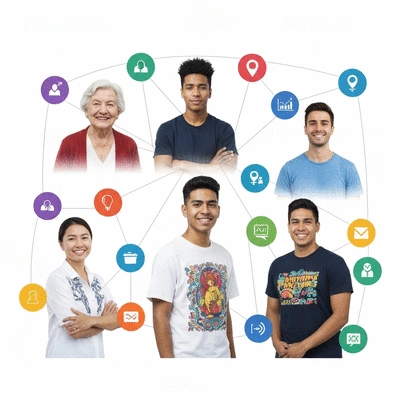Demographic Segmentation
Categorizing based on age, gender, income, education, and location for targeted messaging. Essential for foundational understanding.

Did you know that 71% of marketers believe that audience segmentation is essential for effective social media marketing? Understanding your audience on a deeper level can transform your engagement strategies and lead to lasting connections.
Understanding your audience is paramount for effective social media engagement. Here are the core segmentation strategies to tailor your content and marketing efforts.
Categorizing based on age, gender, income, education, and location for targeted messaging. Essential for foundational understanding.
Delves into values, interests, and lifestyles. Connects with audience beliefs and aspirations for deeper engagement.
Focuses on user interactions, purchasing habits, and engagement levels. Helps identify patterns for tailored outreach.
Tailors content based on location, hobbies, or preferences, ensuring relevance and timely messaging for specific groups.
Analyzes devices, software, and platforms used by the audience. Optimizes content for preferred delivery channels.
Combines multiple data points for nuanced profiles. Understands how various identities influence user behavior.
In today’s digital landscape, understanding your audience isn't just important—it’s essential! When we talk about audience segmentation, we’re diving into the practice of breaking up your larger audience into smaller, more manageable groups. This allows you to tailor your content and marketing strategies to meet the specific needs of each segment. So, why is this vital? It drives engagement, improves conversion rates, and ultimately enhances your brand's presence on social media.
Think about it: if you’re speaking to everyone, you’re really speaking to no one. By segmenting your audience, you can deliver the right message to the right people at the right time. At Likers Network, I’ve seen firsthand how effective audience segmentation can transform online engagement. Let’s dig deeper into the types of segmentation strategies you can use!
Audience segmentation is the practice of dividing your audience into distinct groups based on shared characteristics. This can include demographics, interests, behaviors, and even psychological factors. The beauty of segmentation lies in its ability to create more personalized experiences for users, which can lead to better engagement and loyalty.
Identifying the unique needs and preferences of your audience helps you develop content that resonates and drives action. This is especially crucial in the fast-paced social media world, where attention spans are short, and competition is fierce. For more detailed insights into effective audience segmentation, you can refer to this research on social media marketing strategies.

When it comes to audience segmentation, there are several approaches you can take. Here’s a breakdown of some of the most effective strategies:
Each approach allows you to understand your audience in diverse ways, leading to more innovative and effective marketing strategies. Let’s explore these options in further detail!
Demographic segmentation is one of the most straightforward approaches. It involves categorizing your audience based on age, gender, income, education, and location. This information is crucial for targeting your marketing and tailoring your messaging. For instance, a brand targeting millennials will likely communicate differently than one aimed at baby boomers.
Utilizing this data helps businesses craft campaigns that resonate with specific groups. You wouldn't speak the same way to a teenager as you would to a retiree, right? Tailoring your messages based on demographics can lead to significantly higher engagement rates. The importance of understanding target audiences is further highlighted in this study on effective marketing strategies.
Moving beyond just demographics, psychographic segmentation dives deeper into the values, interests, and lifestyles of your audience. This approach considers what motivates your audience, allowing you to create content that aligns with their beliefs and aspirations. For example, if your target audience values sustainability, showcasing eco-friendly practices can enhance brand loyalty.
It’s about connecting with your audience on a personal level—something I prioritize at Likers Network. By understanding what drives your audience, you can craft compelling content that speaks directly to their hearts!
Behavioral segmentation focuses on how users interact with your brand. This includes their online behaviors, such as purchasing habits, engagement levels, and even responses to previous marketing efforts. By analyzing this data, you can identify patterns and tailor your outreach accordingly.
This approach not only helps in retaining customers but also enhances their overall experience with your brand. Remember, it’s all about fostering relationships, not just making sales!
Geographic segmentation allows you to tailor your content based on where your audience is located. This is particularly effective for businesses with localized offerings or events. You wouldn’t promote a winter sale in a region where it’s summer, right?
In addition to geography, interest-based segmentation can help you reach potential customers based on their hobbies or preferences. This dual approach ensures that your messaging is relevant and timely, making it more likely to grab attention.
In an age where technology plays a significant role in our lives, understanding your audience’s tech preferences is vital. Technographic segmentation involves examining the devices, software, and platforms your audience uses. For instance, knowing whether your audience prefers mobile apps over desktop websites can guide your content delivery methods.
This insight allows you to optimize your campaigns for the channels your audience frequents most, ensuring you’re not just heard, but also seen!

Finally, intersectional audience mapping goes beyond individual segments and combines multiple data points to create more nuanced audience profiles. This holistic approach helps in understanding how various aspects of identity—like race, gender, and socioeconomic status—interact and influence user behavior.
This method enables brands to craft highly personalized campaigns that resonate with diverse audiences. At Likers Network, we believe in the power of intersectionality to drive authentic connections! Further examples of how audience segmentation can be applied are evident in various reports, such as this report on audience segmentation strategies.
Which audience segmentation strategy do you think will be the most effective for your brand? Share your insights below:
As we dive into the world of social media engagement, it’s clear that strategic audience segmentation is not just a good practice—it's essential! By understanding the different segments of your audience, you can tailor your content and messaging to resonate more deeply, creating a stronger connection with your community.
When we take the time to analyze our audience, we can discover insights that help improve engagement rates and overall satisfaction. This isn’t just about numbers; it's about building real relationships. Remember, every like and share reflects someone's connection to your message!
By implementing these strategies, you can enhance your social media presence significantly. At Likers Network, we believe in the power of understanding our audience. Let’s keep the conversation going and see how our insights can evolve!
Now that we've explored the importance of audience segmentation, it’s time to put these insights into action! Start by defining who your audience is and segmenting them into groups that make sense for your objectives.
Don’t forget to leverage tools like social listening and analytics to stay connected to your audience's changing needs. By integrating these methods into your marketing plan, you'll not only boost engagement but also cultivate a loyal community that thrives on meaningful interactions.
Here is a quick recap of the important points discussed in the article:
Effective Audience Segmentation for Engagement

Did you know that 71% of marketers believe that audience segmentation is essential for effective soc
Gaming Communities and Digital Culture

Have you ever stopped to consider how gaming communities shape not just individual players, but enti
Effective Audience Segmentation for Engagement
Gaming Communities and Digital Culture
Social Media Growth Tactics
Social Media Trends to Watch
Grow Your Audience with Hashtags